Your browser does not fully support modern features. Please upgrade for a smoother experience.
Please note this is a comparison between Version 1 by Dua' Ghosheh Wahbeh and Version 2 by Peter Tang.
Open educational resources (OERs) are defined by UNESCO as any teaching, learning, or research materials, located in the public domain, in any format and medium, under a copyright released under an open license, which permit free access, reuse, repurpose, adaptation, and redistribution by others. The GHOSHEH model is considered an innovation based on the definition of innovation as an idea, practice, or object that is perceived as new. It supports OERs through multiple learner-centered strategies with authentic assessments, and focuses on practice and reflection.
- open educational resources (OERs)
- instructional design
- models for creating innovations
- GHOSHEH model
- theory for diffusion of innovation (DOI)
1. Introduction
One of the most important purposes of education is to build human capacities by preparing learners to cope with accelerating global changes. This can be managed by teachers who are responsible for helping learners to create their own innovations that benefit their societies and others [1]. In order to do so, teachers should consider the essence of sustainable development that focuses on preparing learners to be able to improve life’s quality and preserve the world for all generations [2].
Sustainable development can be achieved by adopting open educational resources (OERs) that provide opportunities for learners to engage with others and innovate globally at no cost. OERs are defined as free learning, teaching, or research materials, that promote lifelong education; OERs are shared via a public domain to be used, reused, revised, remixed, or redistributed freely, in order to benefit and empower learners regardless of different barriers [3][4][5][3,4,5].
Researchers have revealed that using OERs has the potential to enhance teaching by developing teachers’ professional competencies, including knowledge, skills, attitudes, and values [3][5][6][3,5,6], in addition to enhancing teachers’ open practices and digital literacy [7]. However, others have found that some teachers were not aware of OERs, and had negative attitudes towards them [8][9][8,9]. Thus, adoption of the OERs has been limited because teachers, who are considered pivotal actors in the adoption of OERs, were not engaged [9], and preferred to use traditional resources, such as textbooks, rather than OERs [8]. In order to engage teachers, it is necessary to provide them with clear insights about the sequence and different contexts of OER implementation in education and using appropriate technologies to teach any content [3][9][10][3,9,10]. This provision should be supported by what are called instructional design (ID) models. An ID model is a representation, order, or structure that translates theory into practice by simplifying complex events, thus providing visualization and explanation for an intended plan [11].
The impacts of OERs and the lack of an ID model that focuses on adopting or creating innovative OERs led the first researcher to develop a new model called the GHOSHEH model for creating innovative OERs. This model incorporates OERs with learner-centered strategies that enable learners to practice, reflect on their practice, solve problems, and create innovative OERs [12][13][12,13].
The GHOSHEH model is considered an innovation based on the definition of innovation as an idea, practice, or object that is perceived as new [14]. Thus, there is a need to first introduce this new model in order to have teachers adopt it. Adopting innovations requires following an appropriate theory for diffusion of innovation. One of the leading theories is Rogers’ theory for diffusion of innovation (DOI). Rogers outlined that it is dangerous to consider all innovations as equivalent, because some innovations fail and others succeed [14]. Therefore, innovations, as with any new topic, have to be introduced and adopted before taking the responsibility of implementing them [15]. Rogers’ theory includes a process that enables an examination of innovations from clients’ perspectives.
2. OERs
OERs are defined by UNESCO as any teaching, learning, or research materials, located in the public domain, in any format and medium, under a copyright released under an open license, which permit free access, reuse, repurpose, adaptation, and redistribution by others [16]. OERs enable users to retain (make one’s own copy after downloading an original OER), revise (edit, adapt, and modify the original OER), remix (create a new OER by revising or combining the original OER with other materials), reuse (use the original or newly remixed OER publicly), and redistribute (share the original OER or a new remixed OER with others) [3][17][3,17].
Analysis of the literature revealed the impacts of OER on both teachers’ and learners’ competencies [5][18][19][5,18,19]. On the one hand, OERs are expected to develop teachers’ digital literacies and open practices [7][10][7,10] and socio-cultural competencies [17]. On the other hand, OERs increase the opportunities for users to exchange educational experiences [4][5][7][18][4,5,7,18], and encourage improvement of users’ technological skills [3], since most OERs depend on technology, which is considered the main driver of innovation. Furthermore, OERs facilitate scaling up of educational resources, and thus promote globalization and internationalization of education [3][20][3,20].
Despite the positive impacts of OERs on teachers’ and learners’ competencies, some studies revealed that teachers in some schools have negative attitudes towards using OERs, such as those in Kenya’s primary and secondary schools [8] and at universities such as the Dutch University of Applied Sciences [9], due to poor infrastructure, lack of access to devices for both teachers and students, lack of basic technological skills among teachers, and absence of administrative support and appropriate training programs to create awareness about the existence and benefits of OERs [8].
Negative attitudes of teachers could also be related to the claim that OERs may decrease innovation opportunities for individuals, due to the ease of copying others’ work, and plagiarism or other dishonest activities [17][18][17,18]. Nevertheless, if people are educated about digital ethics, they will preserve people’s intellectual rights [18]. Therefore, the responsibility of teachers has increased due to the intention of education to instill ethical values in students besides developing cognitive abilities and creativity [17]. This has increased the teachers’ need to use guides that assist them to prepare learners for the modern world. These guides include ID models.
ID models consist of representations and structures that translate theory into practice by simplifying complex events and providing visualization and explanation of an intended plan. Some ID models represent the steps that are recommended to implement a design process, which simplifies practice. However, these models require some interpretation in order to provide details for specific applications. Richey [11] classified ID models into two types: The first is called a conceptual model, and it identifies and shows the interrelationships of variables that impact a design process. The second type is called a procedural model, and it addresses the selection and ordering of learning activities, such as Gagne’s Events of Instruction model. This researchtudy focused on a procedural ID model that specializes in creating innovations.
3. Models for Creating Innovations
A model for creating innovation is defined as an ID model that includes a systematic teaching and learning plan to provide guidelines for teachers to organize teaching and learning processes based on principles of creative problem-solving, to promote the creation of educational innovation [1]. One of these models was developed by Seechaliao in 2018, based on the principles of creative problem-solving and social media in real-life situations [1]. Implementation of the resulting model revealed that it could effectively promote the creation of educational innovation for pre-service teachers. However, social media that is included in the model should be updated continuously in order to select that which is most appropriate for learning activities, students’ learning styles, and their behaviors [1].
Another instructional model for creation innovation was published in 2018. The model, called the ‘C2I model’, was designed by Jirasatjanukul and Jeerungsuwan (2018) and was based on both connectivism and constructivism theories for creating innovations in real world experiences. Connectivism theory emphasizes digital eras and the learner’s abilities for communication and cooperation, with a focus that learning takes place both inside and outside the learner—it is not just an internal activity [21][22][21,22]. Recently, the Internet has allowed for the connection of a learner to the outside world by enabling him to use the needed resources to construct his own knowledge and manage relationships with experts all over the world. Constructivism explains learning by construction of new knowledge in real-life situations. The design of the model depends on connectivism theory to provide a real-world problem, and on constructivism theory to provide opportunities for learners to construct new knowledge based on practice and communication. Moreover, the C2I model includes another component, which is the innovation of learning products in the real world. Teaching and learning activities of the C2I model are based on the AAA model. AAA is an abbreviation for an ID model which consists of three main processes: analysis, activities, and assessment. The analysis process centers on the learner, the learner’s needs, content, and context. As for the activities process, it consists of what the facilitator will do to reach objectives, and this includes teaching and learning strategies. Finally, the process of assessments depends on oral testing, practice, training, tests, and authentic assessment [21].
A comparison of the Seechaliao model and C2I reveals that both designs focus on creative problem-solving and social media to address real situations. However, the C2I model provides opportunities for learners to connect to the digital world and includes clear processes that could develop learners’ innovation skills.
4. The GHOSHEH Model for Creating Innovative OERs
The impacts of OERs and the gap that exists in having a model that focuses on creating innovative OERs or adopting them, led the first researcher to construct the GHOSHEH model for creating innovative OERs. The model was constructed based on the processes of the AAA model and the main principles of the C2I model, including creative problem-solving and connection to the digital world, as shown in Figure 1.
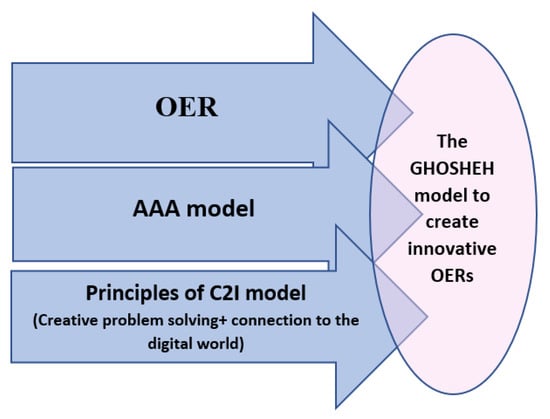
Figure 1.
The principles on which the GHOSHEH model is based.
Figure 1 reveals that the model is mainly based on OERs, creative problem solving, and the AAA model. Therefore, it comprises the three main processes of AAA, in addition to a fourth process that focuses on peer sharing of OERs, as follows:
-
Analysis: the base of the model includes analysis of content, learners’ needs, resources, contexts, and time, in addition to educational objectives and related OERs;
-
Activities: The model’s activities are organized hierarchically to assist learners in using OERs to solve a problem that leads to the creation of other innovative OERs. In addition, the model’s activities encourage learners to share their innovative OERs both locally and globally;
-
Assessment: the model focuses on a formative assessment followed by feedback;
-
Peer sharing: A new process called peer sharing was added to this model. This process requires sharing the created OER with peers all over the world. Peers can provide feedback and repurpose the resulting OER to create another OER based on the first one.
Furthermore, the GHOSHEH model was developed after analyzing Palestinian teachers’ needs to benefit from OERs and to have a guide for adopting OERs and assisting learners to create innovative OERs. The researcher depended on literature, in addition to her more than 11 years’ experience in the domain of ID. The first version of the model was constructed in 2020 [12][13][12,13]. After that, the model was validated and developed further based on the results of internal validation.
5. Validation of the GHOSHEH Model for Creating Innovative OERs
ID model validation is either internal or external. The role of internal validation is to confirm the components and processes of a proposed model. This type of validation could be considered formative evaluation. Internal validation of ID models could be tested by a process called expert review, in which experts critique the proposed model in terms of its structure, components, and use. Moreover, internal validity can be tested using another approach called usability documentation, which involves systematic documentation of model implementation procedures, including the time, resources, and challenges that can be described within a case study. External validation focuses on the impact of the proposed model’s products and is mostly tested by field evaluation during the implementation process [11]. The validation of the GHOSHEH model was conducted according to the processes in Figure 2.
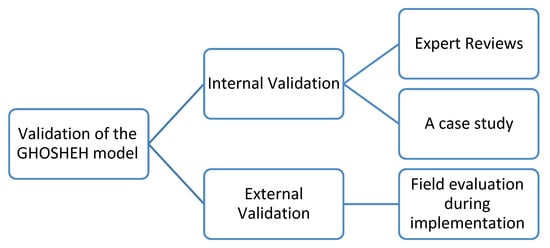
Figure 2.
The processes of validation for the GHOSHEH model.
As shown in Figure 2, the internal validation of the initial version of the GHOSHEH model focused on a case study that will be described later. Moreover, it focused on expert reviews that were done in order to verify the components and processes proposed in the GHOSHEH model. Expert reviews were accomplished by having two panels of international experts review the model: the first panel consisted of six Palestinians, and the second had ten international experts from the United States, China, Spain, India, Sweden, Jordan, Algeria, and Egypt. All the experts were selected due to their specific backgrounds and specialty in open education, ID, OERs, and teacher training. Eight experts have an academic background as educators in these international universities: Delaware, Suqian, Columbia Quindío, UNIR, Wawasan Open University, Al-Aqsa University, Amman Arab University, and Nour Bachir University Centre. Two experts are independent educational consultants who have experience in the Palestinian context, and the other four experts are trainers of teachers who work in the National Institute for Educational Training (NIET) in Palestine. All the participants are researchers: six of them conduct research in the area of ID, five in the area of open education and OERs, and the others in the area of teaching and learning in general. In addition to expert reviews, this researchtudy includes a case study that provides systematic documentation of model implementation, which ensures accurate results of expert reviews. The developed model is shown in Figure 3.
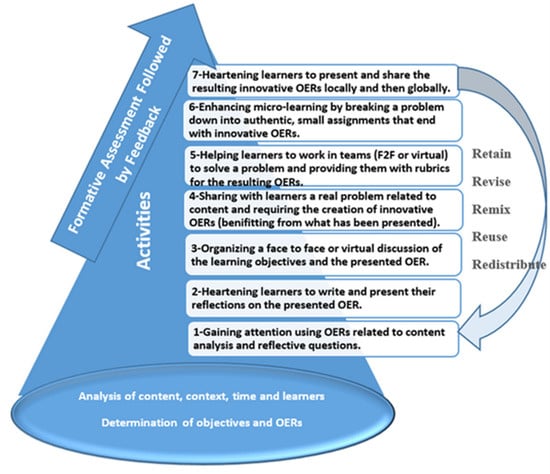
Figure 3.
The sequence of steps of the GHOSHEH model for creating innovative OERs.
Figure 3 shows that the base of the GHOSHEH model includes analysis of content, learners’ needs, context, and time. In addition, it focuses on determination of educational objectives and selecting appropriate OERs. This process is conducted before designing activities to be considered in the design. Activities are arranged hierarchically, as each activity is a requirement for the next one. Assessment is formative, continuous in line with activities, and followed by feedback. After sharing the innovative OERs, the OERs can be retained, revised, remixed, reused, or redistributed by learners and teachers all over the world, which maintains sustainability.
The impact of the GHOSHEH model is based upon the validity of the theories that it is based on. A review of the literature on these theories was conducted in order to determine the elements that might be incorporated into the proposed model. The GHOSHEH model consists of the following theories.
First is Kolb’s experiential learning theory. This theory emphasizes the central role of experience in combination with perception, cognition, and behavior, in the learning process. Many educational institutions offer experiential education programs, such as classroom experiential learning exercises, to add direct experience components to traditional academic studies. Kolb’s theory is widely considered a useful framework for learning-centered educational innovation, including ID and life-long learning [23][24][23,24]. However, designing experiential learning activities requires an instructor who can assist in performing these activities using instructional models that enable learners to practice what they learn on real-life problems [25].
Second is the sociocultural theory [26], which is combined with the experiential theory. The sociocultural theory focuses on the role of social interactions in learning, and is executed by dividing students into groups to cooperate, support each other, discuss reflections, and share experiences. This enables learners to do many tasks in a short time, while the teachers scaffold the learners through continuous assessment and constructive feedback. Third is the cognitive constructive theory, which is reflected by challenging learners with a problem that requires bridging previous experiences to new ones. The included problem is expected to cause the disequilibrium state described by Piaget [27].
Fourth is Gagne’s theory. The GHOSHEH model is composed of small tasks arranged hierarchically according to complexity, the same way tasks are arranged in Gagne’s events—especially in the first levels of the model. However, the model aligns tasks according to the context of learners who aim to reuse, reproduce, and redistribute OERs in order to solve real-life local or global problems. This is in addition to the opportunities—for practice, reflection, working in groups, and communicating with peers all over the world—that are gained from the previous three theories.
The fifth is connectivism. It focuses on both the internal and external aspects of learning that take place among learners. The combination of the five theories is presented in Figure 4.
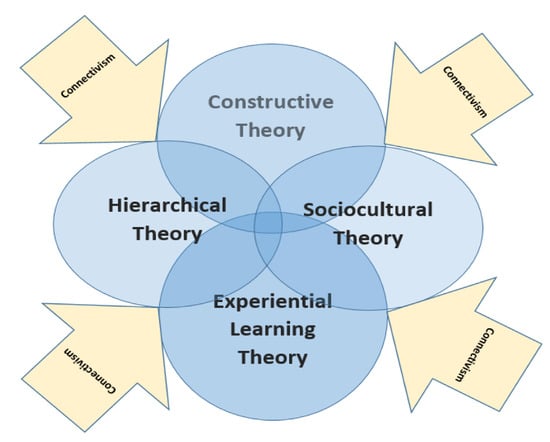
Figure 4.
Integrations of theories that form the GHOSHEH model.
Figure 4 shows how the model is rooted in the last five theories—four of which focus on learning as an internal process. However, the fifth one—connectivism—permeates all theories because it focuses on both the internal and external aspects of learning.
As mentioned before, the GHOSHEH model is also based on creative problem-solving. However, it integrates this strategy with the cooperative learning strategies. Moreover, it focuses on practice and reflection, authentic assessment, and learning differentiation, as shown in Figure 5.
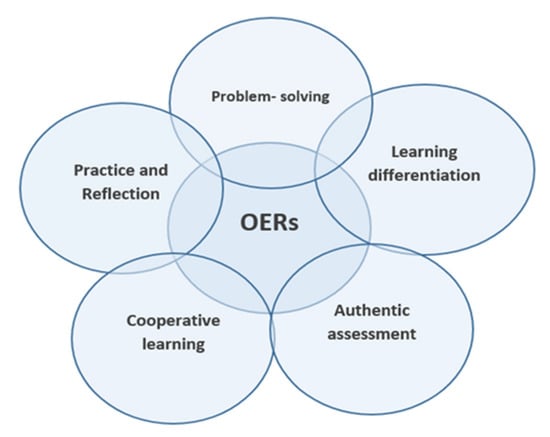
Figure 5.
Strategies and approaches of the GHOSHEH ID model.
Figure 5 reveals that the GHOSHEH model benefits from the potential integration of OERs, cooperative learning, and problem-solving. This integration was mentioned by Thakur and his colleague, who reviewed 52 articles and concluded that PBL is an instructional approach that allows learners to practice cooperative learning by working in small collaborative groups, on realistic and open-ended problems. This empowers learners to develop their creative thinking and reasoning, decision-making, scientific skills, communication, self-regulated learning, teamwork, leadership, and lifelong learning skills [28]. Moreover, Kavrayici pointed out the positive and significant relationships among problem-solving, communication skills, and classroom management competency of teachers [29].
Learning differentiation is a part of cooperative learning that is supported by authentic assessment of the outcomes. Moreover, this is also represented by providing chances for learners to cooperate in developing rubrics used to evaluate the students’ performances. In addition, the model focuses on reflection in the learning process from the beginning, as it organizes the teaching process to start from describing an OER, then gradually asks each student to reflect and write his reflection in the presented OER. This reflection contributes to deepening learners’ knowledge, identifying strengths in what they have learned, and pointing out what needs to be developed, thus leading to self-evaluation and personalization of learning [30].
6. Rogers’ Process for Diffusion of Innovations (DOI)
As shown in Figure 2, the external validation of the GHOSHEH model depends on the implementation and evaluation of the model. Before implementing the model, there is a need to follow a process for introducing it. Rogers’ process for diffusion of innovation was followed. This process was selected after considering the GHOSHEH model as an innovation according to Rogers’ definition, in which he referred to an innovation as any new idea, resource, tool, process, or model [14]. Rogers’ process includes providing users with sufficient knowledge about an innovation, forming attitudes about the innovation, making a decision to adopt or reject it, and implementing an idea to confirm this decision [15]. The process includes introducing and adopting innovative ID models. Rogers’ process relies on these five stages [31]:-
Knowledge: this stage includes creating an awareness of the innovative model by providing descriptions that enable adopters to answer the question: Why should we use this model?;
-
Persuasion: this stage encourages the decision to adopt the innovative model and can be facilitated when the instructional designer provides knowledge about the model rationale and fulfilment of real needs;
-
Decision: This stage leads to a decision by adopters who will either adopt or reject the innovative model. Instructional designers can facilitate this phase by providing opportunities for adopters to try out the model before committing to it;
-
Use: This stage includes actual usage of the new model after a period of continuous education and professional development associated with the model’s adoption. An instructional designer can support adopters’ use of the model by providing instruction and showing adopters how to use the ID model’s features;
-
Confirmation: This stage occurs because of adopters’ evaluations of their decision to implement the innovative model and their satisfaction with the results. Therefore, instructional designers should assist adopters to understand how to integrate the model into their professional practices, and support them by providing appropriate training that decreases challenges and fixes problems of experiencing the model [14][32][14,32].
-
Relative Advantage: the advantages of the innovative model should be clear to adopters and have a value that exceeds that of the current models they use;
-
Compatibility: The alignment of an innovative model to adopters’ beliefs, interests, concerns, needs, and internal conditions related to social, cultural, ideological, and pedagogical aspects. To ensure a high compatibility, the innovation must meet with the clients’ needs [31];
-
Complexity: the difficulty of using an innovative model makes it complex and can negatively impact adopters’ desires to use the model;
-
Trialability: the ability of an innovative model to be tested on a limited basis;
-
Observability: This is related to the visibility of an innovative model’s results. Adopters should observe the outcomes and outputs of an ID to adopt it.
